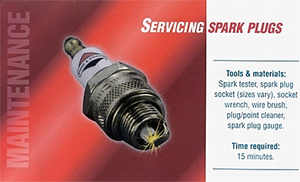How to check, clean and change small engine spark plugs?
Learning how to check, clean and change a spark plug is a valuable part of your DIY education. Whether you’re doing regular maintenance or troubleshooting why your lawn mower or small engine won’t start, this 3-step guide will provide the resources you need to keep your machine running right!
Checking Small Engine Spark Plugs
How To Clean Fouled Spark Plugs
Changing Spark Plugs in Lawn Mowers, Snow Blowers & Equipment
WARNING: Always read the engine and equipment manual(s) before starting, operating, or servicing your engine or equipment to avoid personal injury or property damage. See an authorized dealer or contact Briggs & Stratton if you are unsure of any procedure or have additional questions. Find all Engine Safety Warnings

The electrodes on a spark plug must be clean and sharp to produce the powerful spark required for ignition. The more worn or dirty spark plugs are, the more voltage - and the greater the tug on the rewind - required to produce an adequate spark.
If you haven't tuned your engine recently, your mower won't start and/or you have to tug repeatedly on the rewind to start the engine, a damaged spark plug may be the culprit. These problems may also cause excessive fuel consumption, deposits on the cylinder head and oil dilution.
Luckily, spark plugs are one of the easiest engine components to repair and an inexpensive one to replace.
When To Check & Replace Spark Plugs
For standard lawn mower and small engine maintenance, you should check and/or replace spark plugs:
- once a season
- every 25 hours of use
- if your lawn mower our outdoor power equipment won’t start
How To Check for a Fouled or Damaged Spark Plug
- Step 1: Disconnect the spark plug lead. Then, clean the area around the spark plug to avoid getting debris in the combustion chamber when you remove the plug.
- Step 2: Remove the spark plug using a spark plug socket.
- Step 3: Clean light deposits from the plug with a wire brush and spray-on plug cleaner. Get full cleaning instructions below.
- Step 4: Inspect the spark plug for very stubborn deposits, or for cracked porcelain or electrodes that have been burned away. If any of these conditions exists, replace the spark plug.
- Step 5: Check the spark plug gap and adjust as necessary.
- Step 6: If it seems in working order, replace the plug, taking care not to over-tighten (15 ft. lbs. MAXIMUM) and re-attach the spark plug lead.
- Step 7: Start Your Engine
If the engine tries to turn over (even for a second) and dies, then you have spark. This would indicate the problem probably lies somewhere else (fuel, carburetor, valves, etc.). If the engine does not turn over at all, then there may be a problem with your ignition system. The first thing to do is change the spark plug.
>> Review the FAQ on troubleshooting ignition system problems to learn how a spark tester can identify problems with the ignition coil, switch, flywheel or other small engine par
To safely clean a spark plug, you should use a wire brush or spray-on plug cleaner specifically designed for this ignition part. You can also use a sturdy knife to scrape off tough deposits.
Note: NEVER clean a spark plug with a shot blaster or abrasives.
If your spark plug doesn’t pass the tests above, you’ll need to replace it. This is one of the easiest steps in lawn mower or small engine maintenance.
For pre-season tune-ups and end-of-season storage, consider a Briggs & Stratton small engine tune-up kit that includes everything you need, including parts (spark plug(s), oil filter, air filter) and fluids (lawn mower oil, fuel stabilizer, etc) specific to your engine.
- Find the right spark plug(s) & adjust gap settings.
- Disconnect the plug lead and remove with a spark plug socket.
- Replace with your new plug, taking care not to over-tighten (15 ft. lbs. MAXIMUM) and re-attach the spark plug lead.
Still have questions? Watch this easy guide to change the spark plug or find more tips for troubleshooting lawn mower engine problems, check out our full list of Frequently Asked Question on Repairing Small Engines or contact a Briggs & Stratton service dealer near you.




